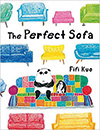
Download the PDF of this article
This is a simple story about two friends, Panda and Penguin, and their hunt for a new sofa. The problem is that each new sofa they find on their shopping trip has always something  wrong with it. One is too small, another is too big, while another is too squishy, and on it goes. At the end of the day, when night has fallen, they finally give up and go home – where they suddenly see their old sofa in a new light.
wrong with it. One is too small, another is too big, while another is too squishy, and on it goes. At the end of the day, when night has fallen, they finally give up and go home – where they suddenly see their old sofa in a new light.
It turns out that with a bit of fixing, it was perfect all along. This is, therefore, a book with a moral to it: you may wish for something new, but you should try to be content with what you already have.
Register now to continue reading
Thank you for visiting Nursery World and making use of our archive of more than 35,000 expert features, subject guides, case studies and policy updates. Why not register today and enjoy the following great benefits:
What's included
-
Free access to 4 subscriber-only articles per month
-
Unlimited access to news and opinion
-
Email newsletter providing activity ideas, best practice and breaking news
Already have an account? Sign in here









